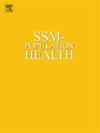Social connections with family and friends in adolescence: Shaping body mass index trajectories into adulthood
IF 3.6
2区 医学
Q1 PUBLIC, ENVIRONMENTAL & OCCUPATIONAL HEALTH
引用次数: 0
Abstract
Objectives
To investigate whether adolescent social connections influence body mass index (BMI) trajectories into adulthood and explore whether associations are moderated by gender, ethnicity or age.
Methods
Data came from 17,719 American adolescents in grades 7–12 at baseline (1994–95) from the National Longitudinal Study of Adolescent to Adult Health. Growth curve models tested associations between baseline social connections and BMI trajectories from waves II-V including interactions for gender, ethnicity and age.
Results
Stronger peer connections were associated with flatter BMI trajectories. For example, BMI for those with high peer contact was 0.79 kg/m2 lower [95% CI -1.20, −0.38] 22 years after baseline, compared to those with low contact. Stronger family connections were associated with steeper trajectories. For example, BMI for those with high family contact was 0.52 kg/m2 higher [95% CI 0.01, 1.02] 22 years after baseline, compared to those with low contact.
Discussion
Among adolescents, stronger peer connections were associated with flatter BMI trajectories and stronger family connections with steeper trajectories. Promotion of peer-based interventions could be explored as a strategy to promote healthy weight trajectories.
求助全文
约1分钟内获得全文
求助全文
来源期刊

Ssm-Population Health
PUBLIC, ENVIRONMENTAL & OCCUPATIONAL HEALTH-
CiteScore
6.50
自引率
2.10%
发文量
298
审稿时长
101 days
期刊介绍:
SSM - Population Health. The new online only, open access, peer reviewed journal in all areas relating Social Science research to population health. SSM - Population Health shares the same Editors-in Chief and general approach to manuscripts as its sister journal, Social Science & Medicine. The journal takes a broad approach to the field especially welcoming interdisciplinary papers from across the Social Sciences and allied areas. SSM - Population Health offers an alternative outlet for work which might not be considered, or is classed as ''out of scope'' elsewhere, and prioritizes fast peer review and publication to the benefit of authors and readers. The journal welcomes all types of paper from traditional primary research articles, replication studies, short communications, methodological studies, instrument validation, opinion pieces, literature reviews, etc. SSM - Population Health also offers the opportunity to publish special issues or sections to reflect current interest and research in topical or developing areas. The journal fully supports authors wanting to present their research in an innovative fashion though the use of multimedia formats.
 求助内容:
求助内容: 应助结果提醒方式:
应助结果提醒方式:


